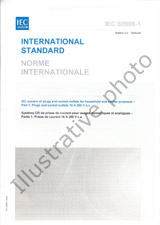We need your consent to use the individual data so that you can see information about your interests, among other things. Click "OK" to give your consent.

IEC 61788-1-ed.2.0
Superconductivity - Part 1: Critical current measurement - DC critical current of Nb-Ti composite superconductors
STANDARD published on 21.11.2006
The information about the standard:
Designation standards: IEC 61788-1-ed.2.0
Publication date standards: 21.11.2006
SKU: NS-413725
The number of pages: 57
Approximate weight : 171 g (0.38 lbs)
Country: International technical standard
Category: Technical standards IEC
The category - similar standards:
Measurement of electrical and magnetic quantitiesConducting materials
Annotation of standard text IEC 61788-1-ed.2.0 :
This part of IEC 61788 covers a test method for the determination of the d.c. critical current of either Cu/Nb-Ti composite superconductors that have a copper/superconductor ratio larger than 1 or Cu/Cu-Ni/Nb-Ti wires that have a copper/superconductor ratio larger than 0,9 and a copper alloy (Cu-Ni)/superconductor ratio larger than 0,2, where the diameter of Nb-Ti superconducting filaments is larger than 1 micrometre. The changes for the Cu/Cu-Ni/Nb-Ti are described in Annex C. The Cu-Ni uses all of the main part of the standard with the exceptions listed in Annex C that replace (and in some cases are counter to) some of the steps inthe main text. This method is intended for use with superconductors that have critical currents less than 1 000 A and n-values larger than 12, under standard test conditions and at magnetic fields less than or equal to 0,7 of the upper critical magnetic field. The test specimen is immersed in a liquid helium bath at a known temperature during testing. The test conductor has a monolithic structure with a round or rectangular cross-sectional area that is less than 2 mm2. The specimen geometry used in this test method is an inductively coiled specimen. Deviations from this test method that are allowed for routine tests and other specific restrictions are given in this standard. Test conductors with critical currents above 1 000 A or cross-sectional areas greater than 2 mm2 could be measured with the present method with an anticipated increase in uncertainty and a more significant self-field effect (see Annex B). Other, more specialized, specimen test geometries may be more appropriate for larger conductor testing which have been omitted from this present standard for simplicity and to retain a lower uncertainty. The test method given in this standard is expected to apply to other superconducting composite wires after some appropriate modifications. Cette partie de la CEI 61788 couvre une methode dessai pour la determination du courant critique continu des supraconducteurs en composite Cu/Nb-Ti qui ont un rapport cuivre/supraconducteur superieur a 1 ou des fils Cu/Cu-Ni/Nb-Ti qui ont un rapport cuivre/ supraconducteur superieur a 0,9 et un alliage cuivre (Cu-Ni)/supraconducteur superieur a 0,2, ou le diametre des filaments supraconducteurs Nb-Ti est superieur a 1 micrometre. Les modifications pour les Cu/Cu-Ni/Nb-Ti sont decrites dans l Annexe C. Les Cu-Ni pourront faire reference aux parties principales de cette norme avec les exceptions listees dans lAnnexe C qui remplacent (et dans certains cas contredisent) certaines etapes du texte principal. La presente methode est destinee a etre utilisee avec des supraconducteurs caracterises par des courants critiques inferieurs a 1 000 A et des valeurs n superieures a 12, dans des conditions dessai normalisees et avec des champs magnetiques inferieurs ou egaux a 0,7 fois la valeur du champ magnetique critique le plus eleve. Le specimen dessai est immerge dans un bain dhelium liquide a une temperature mesuree pendant lessai. Le conducteur dessai en composite Cu/Nb-Ti a une structure monolithique, avec une superficie de section ronde ou rectangulaire inferieure a 2 mm2. Le specimen utilise dans la presente methode dessai a la forme dune bobine inductive. La presente norme presente les ecarts par rapport a la methode dessai qui sont autorises dans les essais de serie, ainsi que dautres restrictions specifiques. Les conducteurs dessai dont les courants critiques sont superieurs a 1 000 A ou dont les superficies de section sont superieures a 2 mm2 pourraient faire lobjet dune mesure par la presente methode, en prevoyant une augmentation de lincertitude et avec un effet de champ induit plus important (voir Annexe B). Il est permis dutiliser dautres geometries de specimen dessai, plus specialisees et mieux adaptees aux essais sur les conducteurs plus grands, qui ne sont pas incluses dans la presente norme, par souci de simplicite et pour reduire lincertitude. La methode dessai decrite dans la presente norme est supposee adaptable a dautres fils supraconducteurs en composite, apres des modifications appropriees.
We recommend:
Technical standards updating
Do you want to make sure you use only the valid technical standards?
We can offer you a solution which will provide you a monthly overview concerning the updating of standards which you use.
Would you like to know more? Look at this page.



 Cookies
Cookies
